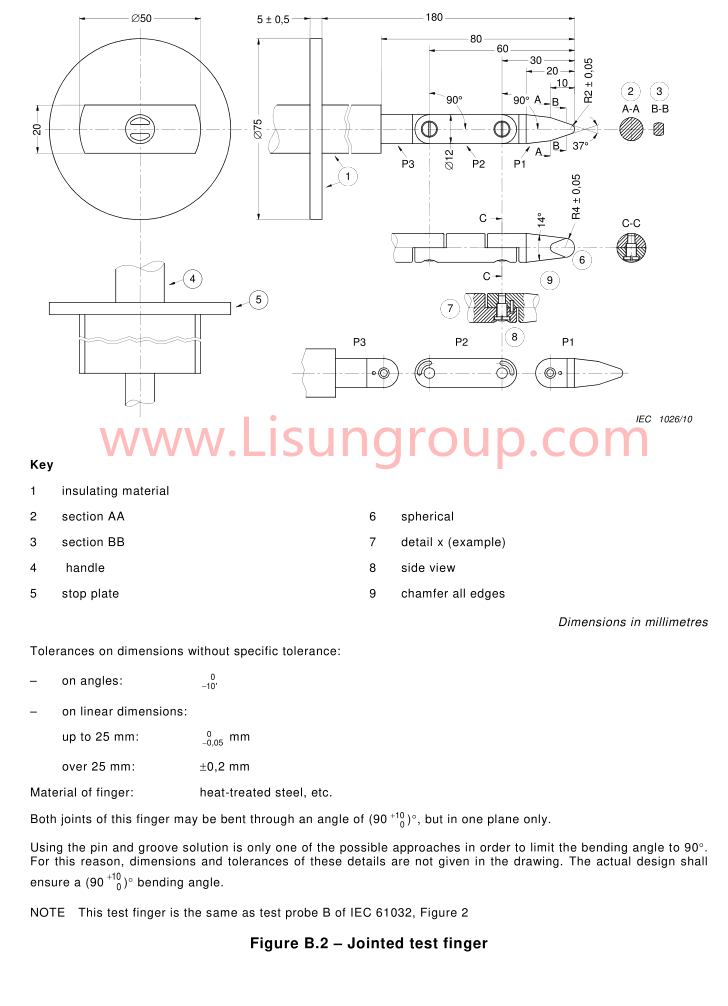Product No: SMT-PB
The Jointed Test Finger of IEC 61010-1 Figure B.2 is a precision safety tool built for testing access to hazardous live parts in electrical equipment for measurement, control, and laboratory use—such as oscilloscopes, industrial thermostats, and signal generators. It mimics human finger movement via two flexible joints (bending 90°±10° in a single plane) to navigate narrow or curved gaps rigid tools can’t reach. Crafted from heat-treated steel (for durability and conductivity) with an insulated handle, it features a 50mm diameter baffle plate to prevent over-insertion. Designed to match IEC 61032 Test Probe B, it applies a gentle 10N thrust, ensuring accurate verification of safety and compliance with global standards for lab and control equipment.
Specifications:
Standards: IEC 61010-1 Figure B.2; IEC 61032 Figure 2 (Test Probe B)
Probe Material: Heat-treated steel (resistance ≤ 0.1Ω; corrosion-resistant; knurled surface for consistent contact)
Handle Material: Insulated plastic (resistance ≥ 100MΩ; heat-resistant up to 120°C; ergonomic grip for precision)
Joint Characteristics: 2 pivot joints; max bending angle: 90°±10° (single plane only); no deformation under 10N thrust
Key Dimensions:
– Knurled Finger Diameter: 12mm ± 0.1mm
– Knurled Finger Length: 80mm ± 0.2mm
– Baffle Plate Diameter: 50mm ± 0.2mm
– Baffle Plate Length: 100mm ± 0.2mm
– Baffle Plate Thickness: 20mm ± 0.1mm
– Total Length (Probe + Handle): 300mm ± 0.5mm
Applied Thrust: 10N ± 0.5N (simulates light human finger contact; standard for measurement/control equipment testing)
Core Function: Mimics finger movement to test access to hazardous parts in lab/control gear; prevents over-insertion via baffle; meets IEC 61010-1 requirements
Test Procedures:
1. Inspect the test finger for loose joints, bent tips, or cracked insulation; confirm conductivity with a test tool.
2. Power on the equipment under test (EUT, e.g., a lab oscilloscope) and set it to normal operating mode.
3. Hold the insulated handle, use the joints to guide the 12mm knurled tip into EUT gaps (panel seams, connector slots).
4. Apply steady 10N thrust—stop if the 50mm baffle touches the EUT or resistance blocks insertion.
5. Check the connected live-part detector for signals (indicating contact with hazardous parts).
6. Record results: Pass if no contact; Fail if the probe reaches dangerous components.
Applications:
1. Testing access to live circuits in laboratory oscilloscopes (per IEC 61010-1:2021 Figure B.2) to prevent technician electric shock.
2. Verifying control panel gaps in industrial temperature controllers (compliant with UL 61010-1:2023) to block finger contact with internal wiring.
3. Safety checks for signal generator chassis seams (per IEC 61032:2017 Figure 2) to avoid exposure to high-voltage components.
4. Quality control for laboratory pH meters during manufacturing, ensuring compliance with IEC 61010-1 safety rules.
5. Post-production testing of industrial pressure sensors (measurement equipment) to validate hazardous part accessibility.

Jointed Test Finger of IEC 61010-1 Figure B.2